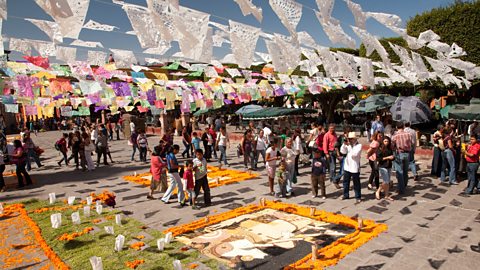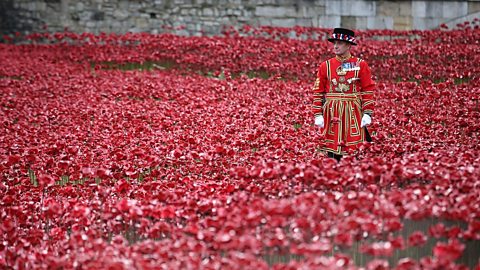With films like The Book of Life and Disney’s Coco, themes around Día de los Muertos (The Day of the Dead) have been brought into the spotlight in recent years.
A national holiday in Mexico, Día de los Muertos mixes Catholic traditions with its Aztec roots in the celebration of Mictecacihuatl, the goddess of death. On 1 November, Mexicans celebrate the Día de los Angelitos (Day of the Little Angels), for deceased children, and 2 November is the Día de los Muertos, for deceased adults. According to Mexican culture, on this night the dead cross over from the underworld to visit their living relatives.
Contrary to popular belief, the Day of the Dead is not the Mexican version of Halloween, though the festivals and parades can start around the same time. The colours, traditions and rituals of the holiday all have special significance. Here are six important symbols of Día de los Muertos.
Remembering the family: The ofrenda
One of the most important traditions of Día de los Muertos is the building of the ofrenda (offering). The ofrenda is an altar where people leave offerings of fruit, seeds, bread, sugar skulls and other comforts such as blankets and pillows for the souls of their loved ones.
It is traditionally split into three tiers. The top tier identifies the dead being invited to the altar with photos, along with Catholic symbols such as images of the Virgin Mary and crucifixes. The second tier invites the dead to feel at home; food and creature comforts might be placed here. The third tier is often decorated with candles, as well as a washbasin, mirror and soap so the deceased can refresh themselves when arriving at the altar.
Relatives of the deceased might gather to pray around the ofrenda, read satirical poems and share joyful anecdotes of their loved ones.

A doorway to the dead: Marigolds
Brightening up awnings, arches and ofrendas, cempasuchil flowers (marigolds) are a prominent symbol of Día de los Muertos. Fresh or sometimes made of paper, marigolds are thought to guide the souls of loved ones from the Land of the Dead to the offerings left out for them. Other significant flowers are white chrysanthemums to celebrate the dead, and gladiolas for remembrance.

A sweet treat: Sugar skulls
Calaveras (skulls) are another important symbol of death in Día de los Muertos, dating all the way back to ancient Mesoamerican (historical north American) societies. Decorated skulls made of sugar or chocolate are traditionally left on ofrendas, and given to colleagues as gifts. The skulls are decorated with different colours to represent other symbols like the sun, marigolds and the Land of the Dead.
The most elaborate skulls can be entered into a competition at the Alfeñique Fair in Toluca, Mexico.

Colourful banners: Punched paper
Papel picado (punched paper) are banners of paper cut into patterns and shapes. Usually made from tissue paper, 40-50 sheets are stacked and then punched with a chisel to create patterns, or folded and cut with scissors.
Each colour of the paper has a different meaning: orange is for mourning, purple is for the Catholic faith, red is for mothers who died in childbirth, green is for the young, white is for the elderly and black is for the Land of the Dead.
≥…»ÀøÏ ÷ baked comforts: Bread of the dead
Pan de Muertos (bread of the dead) is a sweetbread brushed with butter on the outside and sprinkled with sugar. It’s a traditional treat served throughout Día de los Muertos, and often left as a fraternal offering on ofrendas.
The four lines crossing the bread represent limbs of a body, and the ball on the top represents the skull. The lines also look like the tears that people shed when they remember their loved-ones.

A dancing icon: La Catrina
In the early 1900s, political cartoonist and printmaker José Guadalupe Posada made a satirical etching of La Calavera Catrina, a female skeleton with a flowery hat. La Catrina has become a prominent symbol of death in Mexico, and is the inspiration for a lot of Day of the Dead makeup and costumes. People make figurines out of clay, wood or paper mache to celebrate her, and she is often seen dancing in parades. She is a reminder to remember the dead with good humour and warmth.
These traditions are an important way for families to remember their ancestors and pass on their stories. The core of the holiday to celebrate those who have passed on from this world, viewing death in a more positive light and as a natural part of life.
This article was published in October 2020 and last updated in October 2023

Spanish customs, celebrations and festivals
The different festivals and customs of Spanish-speaking countries are well-known throughout the world.

Why do we turn the clocks back?
It's not as scientific as you might think.

Three WW1 memorial sites with incredible stories
All of these sites were built to commemorate those lost in WW1.
